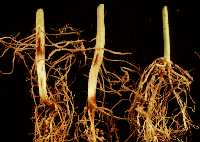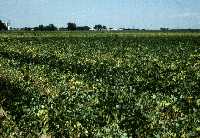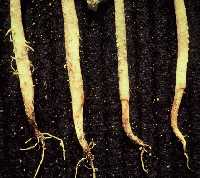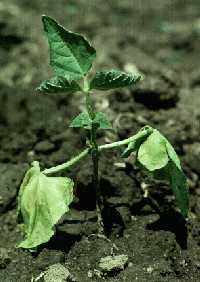by H. F. Schwartz *(5/11)
Quick Facts…
- Common soil-borne diseases of dry beans in this region are Fusarium root rot, Fusarium wilt, Rhizoctonia root rot and Pythium damping off.
- Root rots are favored by moderate to high soil moisture, various soil temperature regimes, soil compaction, poor drainage, continuous or frequent cropping to beans, and other factors that cause plant stress.
- Pathogens survive for years in infected debris and infested soil.
- Disease management relies on crop rotation, proper planting date, pesticides, and other
suggested production guidelines that reduce plant stress.
Many soil-borne fungal pathogens are widespread throughout dry bean and snap bean growing areas of Colorado and surrounding states. Yield losses range from a trace to 100 percent, especially when adverse environmental conditions persist after planting and through flowering. The most common diseases and their pathogens are Fusarium root rot or dry rot (Fusarium solani f. sp. phaseoli), Fusarium wilt or yellows (Fusarium oxysporum f. sp. phaseoli), Rhizoctonia root and pod rots (Rhizoctonia solani), and Pythium damping off, wilt and pod rot (various Pythium species).
Pathogen Survival
Root rot fungi can persist for many years in previously infected bean debris and infested soil by producing overwintering structures. These may be thick-walled spores (Pythium oospores and Fusarium chlamydospores), hyphae (fungal threads of Rhizoctonia), or small dark sclerotia (Rhizoctonia).
Overwintering structures are stimulated to germinate by plant exudates from developing susceptible tissue such as bean roots. Structures also may be stimulated by non-host roots to germinate harmlessly or maintain
and reproduce themselves until susceptible plant tissue becomes available. The inoculum densities (numbers of survival structures per unit of soil) of these pathogens can be reduced by naturally-occurring soil-borne organisms that are antagonistic to them, and by other factors described in the disease management section.
Disease Development
The incidence and severity of each root rot fungus and the disease complex they cause are affected by many environmental, host and cultural factors. Table 1 shows the factors that individually and collectively may enhance root rot disease development as plant stress increases.
| Table 1: Description of factors favoring bean root rot development. | |||
| Factor | Fusarium | Rhizoctonia | Pythium |
|---|---|---|---|
| A. Soil moisture: | low to high | moderate to high | high |
| B. Soil temperature: | high | low – young seedlings high – combined with cold irrigation water | moderate to high |
| C. Soil compaction: | hardpan, poor drainage, or soil compaction | poor drainage | poor drainage |
| D. Organic matter: | (carbon/nitrogen ratio) high percent decomposing tissue at planting | high | high |
| E. Fertility: | low | not known | not known |
| F. Herbicide: | toxicity, especially if cool and moist after planting | toxicity | toxicity |
| G. Bean rotation: | less than 3 years | less than 3 years | less than 3 years |
| H. Other Crops: | not known | sugar beets, potatoes | not known |
| I. Plant density: | high | high | high |
| J. Seed quality/age: | poor/more than 2 years | poor/more than 2 years | poor/more than 2 years |
| K. Cultivation: | root pruning | root/hypocotyl wounds | root pruning |
| L. Irrigation runoff: | within/between fields | within/between fields | within/between fields |
Disease Symptoms
Fusarium

Figure 1: Fusarium root rot symptoms. |

Figure 2: Fusarium wilt infection and vascular discoloration. |

Figure 3: Fusarium wilt yellowing. |
Plants infected with fusarium root rot seldom are killed by the pathogen. The disease symptoms may appear within circular to irregular-shaped sectors within fields. Plants in these sectors may be stunted and yellowed with reduced root systems, exhibit premature leaf drop and have poor pod fill. More commonly, however, affected plants are scattered throughout the field and above-ground symptoms are difficult to see. Initial underground symptoms appear as reddish-brown streaks (lesions) on the hypocotyl and primary root two to three weeks after emergence.
Diseased areas of the plant enlarge with age and gradually turn brown. Symptoms may extend up the main root and hypocotyl to the soil surface. Longitudinal cracks may develop in older lesions. Severely infected primary and secondary roots commonly are killed, but persist on plants as dried remnants. Lateral roots may develop from the hypocotyl above the initial infection site if sufficient soil moisture is available. Later in the season during high temperature stress, severely infected root systems may exhibit internal discoloration (brown to red) of the pith tissue below the first node.
Root symptoms of Fusarium wilt are similar to those caused by Fusarium root rot. Above-ground symptoms first appear on lower leaves as a general yellowing and wilting, then become more pronounced and progress upward into younger leaves. Plant stunting also may be evident, especially if plant infection and high temperature stress occurred during the seedling stage. The leaf margin may turn tan to brown as diseased plants become progressively more yellow. Severely infected plants may exhibit permanent wilting and premature defoliation. The most diagnostic symptom is reddish-brown to orange streaks within the vascular tissue up to and beyond the first node. It usually is evident after the initial appearance of foliar symptoms during pod fill combined with high temperature stress.

Figure 4: Rhizoctonia lesions and microsclerotia. |
Rhizoctonia Root Rot
Rhizoctonia root rot symptoms may occur on scattered plants in a somewhat circular to irregular field pattern. The fungus can cause seedling death (damping off), root and hypocotyl rot, stem cankers and pod rot.
Initial symptoms appear on roots or hypocotyls soon after planting as linear or circular reddish-brown sunken lesions or cankers delimited by a brown to reddish-brown margin. Cankers can enlarge with age and become darker and rough-textured and retard plant growth. The pathogen can invade the central part of the lower stem and produce a brick-red discoloration of older seedlings.
Severely infected seedlings or young plants may be killed or break off at the infected and weakened portions of the hypocotyl. Lesions also can develop on pods in contact with the moist soil surface, and cause pod rotting and seed discoloration.
Pythium
Pythium problems usually are scattered throughout a field, thus the affected sectors do not form a pattern. The pathogen may affect seeds, seedlings, young and older plants, and pods. The fungus can cause seed decay and seedling death.
Initial root symptoms appear as elongated water-soaked areas on the hypocotyl and roots. Symptoms usually occur within one to three weeks after planting. Initially, the infected outer tissue of the stem becomes slimy and can easily slip from the central core at this stage. However, eventually it dries out, becomes sunken, and turns tan to brown in color.
Severely infected plants commonly wilt and die. Pods in contact with moist soil also may become infected and exhibit a watery soft rot and mass of white fungal mycelia (but without forming the hard black sclerotia associated with white mold disease). The pathogen can extensively prune roots, reduce overall plant growth, and destroy much of the hypocotyl and main root system. A water-soaked region on infected seedlings or plants may extend several inches above the soil line with little, if any, visible evidence of the fungus.

Figure 5: Pythium root rot. |

Figure 6: Pythium wilt. |
Disease Management
Soil-borne pathogens of dry beans and other Crops can be managed to reduce but not eliminate damage. Integrated and carefully implemented approaches to crop production reduce disease pressure and plant stress. This enables vigorous plants to more successfully obtain nutrients and moisture during critical vegetative and reproductive periods.
Crop rotation reduces residual populations of all four root rot organisms. A three-year crop rotation with beans planted every third or, ideally, fourth or fifth year is best. Potatoes and sugar beets may increase fungus inoculum in the soil and should not be included in the rotation if a field has a history of Rhizoctonia root rot. Resistant Crops include alfalfa, barley, wheat, oats and corn. Previous crop stubble always should be well incorporated into the soil and decomposed before bean planting. This avoids temporary nitrogen deficiency, hence plant stress, early in the season. Apply adequate, but not excessive, fertilizer after proper soil testing.
Plant dry beans in warm moist soil for rapid germination and emergence. The upper 6-inch profile must be at least 60 degrees F, which most commonly occurs in this region after May 25. Use planting depths of 1.5 to 2 inches to facilitate rapid emergence. Planting rates for pintos should be 60 to 80 pounds per acre or 4 to 5 seeds per foot to minimize inter-plant competition (stress) for moisture, nutrients and light without sacrificing yield potential. Always apply appropriate herbicides according to label directions to minimize plant damage, especially during cool, wet springs.
Plant high-quality, treated, certified seed to maximize plant vigor and potential stand establishment. Most varieties are equally susceptible to root rots in this region, but some varieties are more tolerant to Fusarium infection than other varieties in the West.
Seed and soil treatments are available to protect seed and seedlings from infection. Closely follow label directions. Pythium species can be managed with Apron, Ridomil, or Maxim. Rhizoctonia solani can be managed with Chloroneb, Topsin, Maxim and Terraclor or PCNB. Initial infec-tion by Fusarium can be delayed, but not prevented, by soil fumigation or treatment with Terracoat, Terraclor Super X, or Maxim. The effectiveness of these pesticides can be quickly lost when environmental or cultural conditions become too adverse for proper plant development. Research is underway with biological control products as well.
Fusarium and Pythium populations are reduced by fall plowing, rather than fall or spring disking of previously infested debris. Soil compaction caused by machinery traffic and poor drainage can be alleviated by chiseling (subsoiling) 12 to 20 inches deep between bean rows, or 8 to 12 inches deep immediately in front of the planter and 1.5 inches to the side of the row. Perform routine cultivations carefully to minimize root pruning and hence plant stress and increased infection. Pushing soil up around the base of Fusarium- or Rhizoctonia-infected plants before flowering can enhance lateral root development to reduce the damage caused earlier by root pruning and infection.
Schedule irrigations to provide sufficient water to developing (vegetative growth) and fruiting (flowering and early pod stages) plants without causing moisture stress or excess. Manage irrigation runoff to restrict spread of root rot and other pathogens within and between fields. Where pod rots are problems, extend irrigation intervals near the end of the season to allow the soil surface to dry, thus inhibiting active fungus and white mold development.
It must be emphasized that crop management will be most successful if the producer integrates the recommended strategies of crop rotation, planting date, planting rate, seedbed preparation, certified seed, fungicide treatments, herbicide and cultivation practices, and irrigation procedures.
*Colorado State University Extension plant pathologist and professor, bioagricultural sciences and pest management. 9/99. Portions of this fact sheet were taken from research and Dry Bean Production and Pest Management, Bulletin 562A, H.F. Schwartz, M.A. Brick, R.M. Harveson and G.D. Franc. Revised 5/11.
Go to top of this page.





